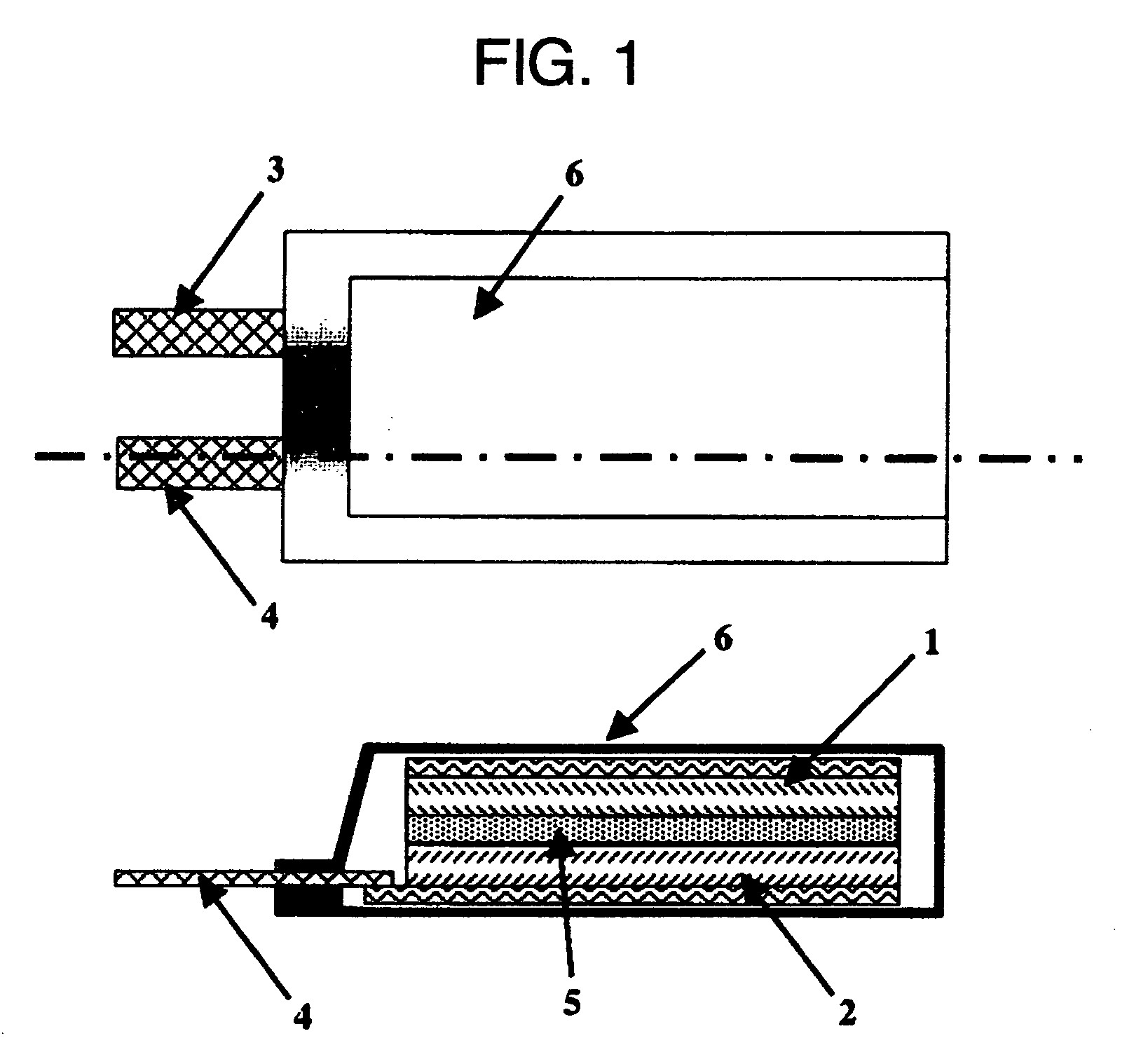Polymeric Electrolyte, Method for Production Thereof, and Electrochemical Element
a polymer electrolyte and electrolyte technology, applied in the direction of non-aqueous electrolyte cells, chemical/physical processes, non-metal conductors, etc., can solve the problems of not meeting the ionic conductivity of the polymer electrolyte, unable to achieve the high reliability originally expected for the polymer electrolyte, and unable to achieve the ionic conductivity. , to achieve the effect of high ionic conductivity and reliability
- Summary
- Abstract
- Description
- Claims
- Application Information
AI Technical Summary
Benefits of technology
Problems solved by technology
Method used
Image
Examples
reference example 1
Production of Polymer A
[0102]Into a 1 L-volume SUS autoclave with a stirrer, 800 ml of dimethyl carbonate as a polymerization solvent and 1.2 g of azobisisovaleronitrile as a polymerization initiator were charged, and subsequently a mixed gas having a pressure ratio of ethylene to carbon monoxide of 1 was charged so as to give a pressure of 4.5 MPa at room temperature. The temperature of the autoclave was raised to 60° C. while stirring. The mixture was reacted for 6 hours while adding the mixed gas so as to keep the pressure at 5 MPa. After cooling, the reactant is removed and the solid content was washed to obtain a white powder.
[0103]It was confirmed from 13C-NMR and an infrared absorption spectrum that this polymer was a product obtained by polymerizing ethylene and carbon monoxide (hereinafter, referred to as “Polymer A”), and the molar ratio of carbon monoxide was 43.2%. In addition, this Polymer A had a weight average molecular weight of 85,000.
reference example 2
Production of Polymer B
[0104]Completely the same operation as in Reference Example 1 was performed except that the pressure ratio of ethylene to carbon monoxide was changed to 2 in Reference Example 1. After cooling, the reactant was removed and the solid content was washed to obtain a white powder.
[0105]It was confirmed from 13C-NMR and an infrared absorption spectrum that this polymer was a product obtained by polymerizing ethylene and carbon monoxide (hereinafter, referred to as “Polymer B”), and the molar ratio of carbon monoxide was 21.3%. In addition, this Polymer B had a weight average molecular weight of 56,000.
reference example 3
Production of Polymer C
[0106]Completely the same operation as in Reference Example 1 was performed except that the pressure ratio of ethylene to carbon monoxide was changed to 10 in Reference Example 1. After cooling, the reactant was removed and the solid content was washed to obtain a white powder.
[0107]It was confirmed from 13C-NMR and an infrared absorption spectrum that this polymer was a product obtained by polymerizing ethylene and carbon monoxide (hereinafter, referred to as “Polymer C”), and the molar ratio of carbon monoxide was 10.9%. In addition, this Polymer C had a weight average molecular weight of 72,000.
PUM
| Property | Measurement | Unit |
|---|---|---|
| weight ratio | aaaaa | aaaaa |
| dielectric constant | aaaaa | aaaaa |
| dielectric constant | aaaaa | aaaaa |
Abstract
Description
Claims
Application Information
 Login to View More
Login to View More - R&D
- Intellectual Property
- Life Sciences
- Materials
- Tech Scout
- Unparalleled Data Quality
- Higher Quality Content
- 60% Fewer Hallucinations
Browse by: Latest US Patents, China's latest patents, Technical Efficacy Thesaurus, Application Domain, Technology Topic, Popular Technical Reports.
© 2025 PatSnap. All rights reserved.Legal|Privacy policy|Modern Slavery Act Transparency Statement|Sitemap|About US| Contact US: help@patsnap.com


